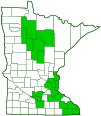tan jumping spider
(Platycryptus undatus)
Conservation • Description • Habitat • Biology • Distribution • Taxonomy
Conservation Status |
|
|||||||
| IUCN Red List | not listed |
|||||||
| NatureServe | NNR - Unranked SNR - Unranked |
|||||||
| Minnesota | not listed |
|||||||
Description |
||
Tan jumping spider is a small to medium-sized jumping spider. It occurs in the United States east of the Great Plains, in southern Ontario, Quebec, and Nova Scotia Canada, and in northwestern Mexico. It is found on foliage, on tree trunks under loose bark, on rocks and fences, in leaf litter, and on walls of buildings. The female is ¼″ to 7⁄16″ (6.06 to 11.36 mm) in length and has a ½″ to ⅝″ (12 to 15 mm) legspan. The body is flattened vertically, which allows it to hide under loosebark. The front part of the body (cephalothorax) is relatively flat, evenly rounded on the sides, and widest just beyond the last row of eyes. The upper side (carapace) is orangish-brown and is densely covered with white and reddish-brown hairs. On the sides the upper half is colored like the upper side, the lower half is blackish-brown. There are four pairs of eyes arranged in what appears to be three rows. The first row of four eyes, consisting of the anterior median eyes (AME) and anterior lateral eyes (ALE), is curved backward. The AME are the middle and forward-most pair of these. They are by far the largest of all of the eyes, almost twice as large as the ALE, and can be moved. There is a band of white hairs below and through the AME. The second row of two eyes are the posterior median eyes (PME). They are very small, one-third the size of the ALE, and are barely or not at all noticeable on most photos. Below each PME there is a pair of close tufts of long black hairs (hair pencils). The third row of eyes is the posterior lateral eyes (PLE). The PLE are set far back on the head and are only slightly wider apart than the first row of four eyes (AME and ALE together). The plate above the mouth (clypeus) is densely covered with gray and white hairs. The prominent mouthparts (chelicerae) corresponding to jaws are brown. There are two sensory appendages (palps) associated with the mouthparts. They are densely covered with white hairs. The abdomen is oval, widest toward the front, and flattened vertically. The upper side is gray in the front and blackish-brown on the sides with a distinctive gray pattern in the middle. The legs are short and mottled orangish-brown and blackish-brown. The sixth segment (metatarsus) is dark at both ends, pale between. The last segment (tarsus) is pale toward the base, dark toward the tip. The male is smaller, ¼″ to ⅜″ (6.66 to 9.23 mm) in length. The band of hairs below and through the AME is reddish or orangish. |
||
Size |
||
Female Body Length: ¼″ to 7⁄16″ (6.06 to 11.36 mm) Male Body Length: ¼″ to ⅜″ (6.66 to 9.23 mm) Legspan: ½″ to ⅝″ (12 to 15 mm) |
||
Web |
||
Jumping spiders do not hunt from webs. |
||
Similar Species |
||
Habitat |
||
|
||
Biology |
||
Season |
||
|
||
Behavior |
||
|
||
Life Cycle |
||
Eggs hatch in the summer. Adults hibernate in winter groups of fifty or more, each spider in its own silken sac, usually under the bark of a tree, sometimes under wood or a stone. The sacs are pressed tightly together forming a single silk blanket. |
||
Food |
||
|
||
Distribution |
||||
|
Sources Barnes, R. D. (1958). North American jumping spiders of the subfamily Marpissinae (Araneae, Salticidae). American Museum Novitates 1867: 1-50. |
|||
| 9/10/2022 | ||||
Occurrence |
||||
|
||||
Taxonomy |
|||
| Class | Arachnida (arachnids) | ||
Order |
Araneae (spiders) | ||
Suborder |
Araneomorphae (typical spiders) | ||
| Infraorder | Entelegynae | ||
Superfamily |
Salticoidea | ||
Family |
Salticidae (jumping spiders) | ||
Subfamily |
Salticinae (typical jumping spiders) | ||
Tribe |
Dendryphantini | ||
| Subtribe | Marpissina | ||
Genus |
Platycryptus | ||
Synonyms |
|||
Aranea undata Aranea lurida Attus cunctator Attus milberti Attus undatus Attus lentus Salticus sundevalli Attus familiaris Attus rupicola Marpissa undata Marpissa conspersa Marpissa varia Dendryphantes undatus Dendryphantes conspersa Dendryphantes varia Marptusa familiaris Marptusa rupicola Marpissa familiaris Marpissa rupicola Metacyrba undata Platycryptus undata Platycryptus undatus |
|||
Common Names |
|||
ondulated flattened jumping spider tan jumper tan jumping spider |
|||
Glossary
Carapace
The hard, upper (dorsal), shell-like covering (exoskeleton) of the body or at least the thorax of many arthropods and of turtles and tortoises. On crustaceans, it covers the cephalothorax. On spiders, the top of the cephalothorax made from a series of fused sclerites.
Cephalothorax
The front part of a spider’s body, composed of the head region and the thoracic area fused together. Eyes, legs, and antennae are attached to this part.
Chelicerae
The pair of stout mouthparts, corresponding to jaws, in arachnids and other arthropods in the subphylum Chelicerata.
Clypeus
On insects, a hardened plate on the face above the upper lip (labrum).
Metatarsus
The sixth segment of a spider leg.
Palp
Short for pedipalp. A segmented, finger-like process of an arthropod; one is attached to each maxilla and two are attached to the labium. They function as sense organs in spiders and weapons in scorpions.
Tarsus
On insects, the last two to five subdivisions of the leg, attached to the tibia; the foot. On spiders, the last segment of the leg. Plural: tarsi.
Visitor Photos |
|||||
Share your photo of this arachnid. |
|||||
| This button not working for you? Simply email us at info@MinnesotaSeasons.com. Attach one or more photos and, if you like, a caption. |
|||||
Alfredo Colon |
|||||
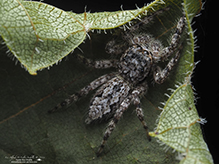 |
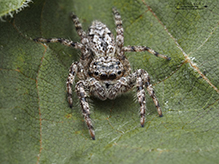 |
||||
One of the biggest Jumping Spiders I have ever seen. |
|||||
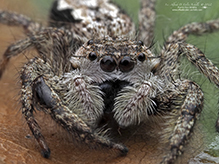 |
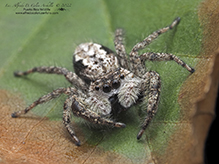 |
||||
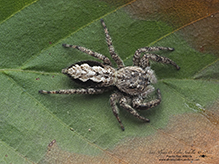 |
|||||
Babette Kis |
|||||
Platycryptus undatus Platycryptus undatus, tan jumping spider, on the house next to Barnes Prairie, Racine Co., WI. Photo was taken on June 24, 2020. |
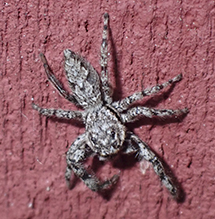 |
||||
Alissa Hawkins |
|||||
found near the docks at a marina on the Mississippi. |
|||||
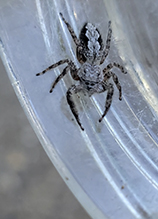 |
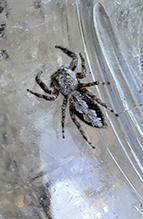 |
||||
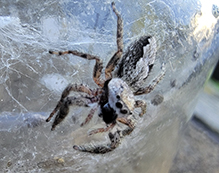 |
|||||
MinnesotaSeasons.com Photos |
|||||
|
|||||

Slideshows |
||

Visitor Videos |
|||
Share your video of this arachnid. |
|||
| This button not working for you? Simply email us at info@MinnesotaSeasons.com. Attach a video, a YouTube link, or a cloud storage link. |
|||
Other Videos |
|||
| Platycryptus undatus building nest Ben Gruver |
|||
About
May 8, 2022 I saw a wild Platycryptus undatus (tan jumping spider) starting her nest on a chiminea in my front yard, and thought it would be interesting to record the process. There are some gaps in the footage, as the storage filled up a couple of times and I had to go copy it off and free up the space. I also missed the last hour or so of her building. I set up the phone, but didn't hit "record". Footage is sped up by 10x, and spans about 4-5 hours of real time, including the gaps. |
|||
| Platycryptus Undatus Female Valthero |
|||
About
May 24, 2020 I had a friend drop by while I was playing Starsector today, and I had to share. Jumping spiders are naturally curious creatures, with very good eyesight; I find that this species tends to be nonaggressive, and they want nothing more than to explore something new to them. In this one's case, that meant jumping on my phone four times before I could get her out of the house. Once outside, she spent several minute looking around as though in wonder before klutzing off of my hand. Jumping spiders are wonderful little hunters. They don't leave cobwebs, unlike other arachnids; they only spin web as as a bungee line, or to protect their eggs. They have great eyesight, and they're actually quite intelligent, for a spider. I've done a couple of videos on them before, but here's aniother. You can tell the gender of this species by the fuzz under their frontal eyes: females have grey fuzz, while males have orange fuzz. I find that it looks rather like a moustache. I think I'll name this one Betsy. |
|||
| Courtship Behavior of a Male Platycryptus undatus Jumping Spider Thomas Shahan |
|||
About
Jun 20, 2010 Found this pair of adult Platycryptus undatus jumping spiders hanging out in the abandoned and dilapidated pavillion seen at the beginning of the video. |
|||
| Platycryptus Undatus-A Cute Jumping Spider Torn80cj |
|||
About
Jun 13, 2012 Also known as the "World's Cutest Jumping Spider" in another video of mine. This is the same species in my first video of me handling a spider for the first time. She may be a relative of the one I recorded back in November, 2010. May even possibly be the same spider, but I doubt she is. |
|||


Created: 9/10/2022
Last Updated:
